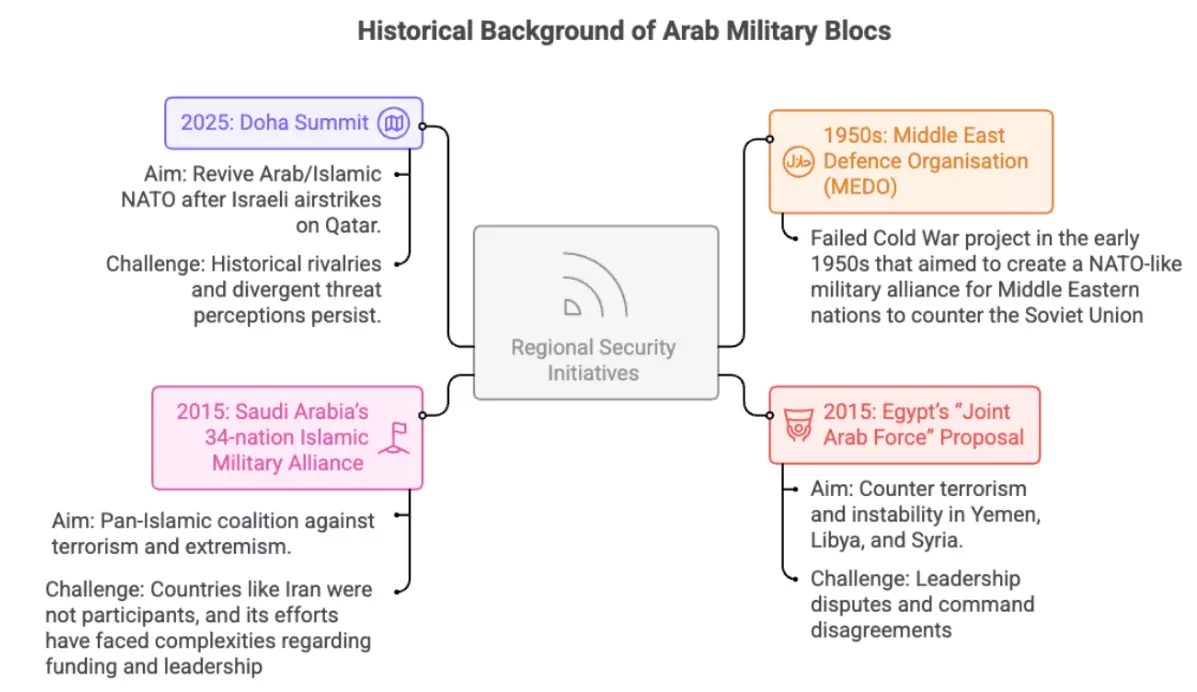The Israeli airstrike on Qatar capital Doha in September 2025 targeting Hamas leaders perceived as a violation of Qatar’s sovereignty and triggered renewed calls for a NATO-style military bloc among Arab and Islamic states.
- Leaders from over 40 countries from the Arab League and Organisation of Islamic Cooperation (OIC) attended the ]Arab — Islamic summit in Doha recently.
About Arab NATO
- Proposed military alliance among Arab and/or Islamic countries.
- Modeled on NATO’s Article 5: An attack on one member is considered an attack on all.
- Objective: Collective defense against external threats (e.g., Israeli airstrikes, Regional conflicts).

NATO (North Atlantic Treaty Organization)
- Genesis: Established in 1949 with the Washington Treaty to counter Soviet expansion post-WWII.
- HQ: Brussels, Belgium.
- Nature: Political & military alliance of 32 countries from Europe and North America.
- Core Principle: Collective defence under Article 5 (invoked only once, after 9/11).
- Founding Members (12): US, UK, France, Italy, Canada, Belgium, Netherlands, Luxembourg, Denmark, Norway, Portugal, Iceland.
- Latest Member: Sweden (2024)
- Ukraine: Applied in 2022; received assurances at Vilnius Summit (2023).
- EU non-members in NATO: Austria, Cyprus, Ireland, Malta.
- Purpose: Provides the transatlantic link for defence, crisis management, and deterrence.
- Funding: Cost-sharing formula based on Gross National Income.
- Partnerships:
-
- Partnership for Peace (PfP): 8 countries, incl. Russia (suspended).
- Mediterranean Dialogue (MD): North African states.
- Istanbul Cooperation Initiative (ICI): Middle East partners.
- UN & EU as international partners.
|
Drivers Behind the Idea
- Security Threats: The Israeli airstrike on Qatar highlighted vulnerabilities in the region’s security architecture and underscored the need for a unified defense mechanism.
- Ongoing conflicts in Gaza, Yemen, and Syria have further strained regional stability, prompting calls for collective defense arrangements.
- Internal Legitimacy: Leaders in the Arab and Muslim-majority countries seek to bolster domestic support by presenting a united front against external threats.
- The proposal for a collective defense mechanism serves as a tool for political consolidation and regional leadership.
- Declining U.S. Reliability: Perceived disengagement of the U.S. as a security guarantor motivates Arab and Muslim states to consider self-reliant defense mechanisms.
- Example: Saudi Arabia and UAE’s caution in Gaza reflects recalibration away from over-reliance on Washington.
- Strategic Competition: Countries seek to balance Israel’s military advantage and share advanced defense capabilities.
- Example: Jordan had previously sought Israel’s air defense expertise for regional security networks.
- Geopolitical Signaling: The Arab NATO concept sends a message to external actors, reinforcing collective bargaining power in global forums.
- Example: Iran’s support for an Islamic NATO signals counter-U.S. influence ambitions in West Asia.
Challenges & Contradictions
- Divergent Threat Perceptions: Different members prioritize different security concerns, making unified action difficult.
- Example: Egypt views Israel as the main threat, Turkey focuses on Kurdish separatism, and Iran emphasizes countering U.S. military presence.
- Shia-Sunni Divide: Sectarian differences complicate trust and operational coordination among member states.
- Example: Iran (Shia-majority) may have conflicting priorities with Sunni-led Saudi Arabia and Egypt.
- Overlap with Abraham Accords: Countries like the UAE and Bahrain, which have normalized relations with Israel under the Abraham Accords, may be hesitant to join a collective defense pact that could antagonize Israel.
- Capacity Constraints: Disparities in military capabilities among member states could hinder the effectiveness of a collective defense arrangement.
- Example: Egypt has a modernized army and air force; Smaller states like Bahrain or Oman can only provide symbolic support.
- Political Rivalries: Competing ambitions and historical mistrust impede alliance cohesion.
- Example: Saudi Arabia seeks regional leadership, Egypt claims military superiority, and Iran pushes for broader Islamic leadership.
Ethical & Long-Term Reflection
- Sustainability of Military Blocs: While military alliances can provide short-term security benefits, their long-term sustainability depends on shared interests, mutual trust, and effective conflict resolution mechanisms.
- Collective Defence vs Diplomacy: Overreliance on military solutions may undermine diplomatic efforts and hinder the pursuit of peaceful resolutions to conflicts.
|
Implications for India
- Strategic and Security Concerns
- Pakistan’s Role in the Alliance: Pakistan’s push for an Islamic NATO, especially with its recent defense pact with Saudi Arabia, could embolden its military stance.
- This development may introduce uncertainties in India’s security calculus.
- Potential Nuclear Implications: The Saudi-Pakistan defense pact provides Saudi Arabia with a nuclear deterrent. This could alter the regional security dynamics and impact India’s strategic positioning
- Diplomatic Balancing Act
- Engagement with Gulf Nations: India has cultivated strong ties with Gulf countries, including Saudi Arabia and the UAE, focusing on energy security, trade, and investment.
- A militarized Arab NATO could complicate India’s diplomatic relations, requiring a delicate balancing act to maintain these partnerships.
- Relations with Israel: India’s growing defense and technological collaboration with Israel, exemplified by the Bilateral Investment Agreement, might face challenges if an Arab NATO adopts policies antagonistic to Israeli interests.
- Economic and Energy Implications
- Energy Security Risks: India’s dependence on Gulf nations for oil imports makes it vulnerable to regional conflicts.
- A militarized Arab NATO could escalate tensions, potentially disrupting energy supplies and affecting India’s energy security.
- Trade and Investment Dynamics: While India seeks increased investments from the UAE, as highlighted by Commerce and Industry Minister, the formation of a military alliance could introduce uncertainties in trade relations and investment flows
- Regional Influence and Strategic Alliances: China’s Growing Influence: China’s strategic relations with Gulf nations have been expanding, potentially at the expense of India’s maritime and trade interests in the region.
Way Forward for India
- Balance Israel and Arab Ties: India should continue to strengthen its strategic partnership with Israel while maintaining robust relations with Arab nations to safeguard its interests in the region.
- India’s Ideological Role: India should advocate for dialogue, confidence-building measures, and inclusive security arrangements to promote lasting peace and stability in the Middle East.
- Energy Diplomacy & Diversification: India should pursue a balanced energy strategy by expanding renewable partnerships and green collaborations.
- Platforms such as the International Solar Alliance (ISA) and joint green hydrogen initiatives can anchor a sustainable and secure energy future while complementing traditional hydrocarbon ties.
- Monitoring and Adaptation: Continuously monitor the developments surrounding the Arab NATO and adapt India’s foreign and security policies accordingly to safeguard its national interests.
- Multilateral Engagement: India should actively participate in regional forums and initiatives to influence the security architecture and promote stability in the Middle East.
- Leverage the Indian Diaspora: Engage India’s large workforce in Gulf states (e.g., 3+ million in Saudi Arabia) to enhance bilateral goodwill.
- Protecting diaspora interests boosts India’s soft power and strategic influence in regional policy calculations
Conclusion
The concept of an Arab NATO reflects the region’s evolving security dynamics and the desire for greater autonomy in defense matters. However, internal divisions, divergent threat perceptions, and geopolitical rivalries pose significant challenges to its realization. For India, the formation of such an alliance necessitates careful diplomatic engagement to protect its strategic interests and promote regional stability.
![]() 22 Sep 2025
22 Sep 2025


